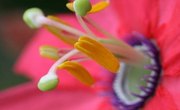
The transfer of a pollen grain to the stigma of a flower pistil is called pollination. How does pollination happen, and what helps to bring pollen grains to a stigma? Sometimes pollen is simply carried by the wind to the stigma of a pistil, but often a pollinator helps with this process. By some estimates, a third of the food humans eat depends on pollinators moving pollen in flowers. Pollination is necessary for the production of most seeds, nuts, vegetables and fruits, which are the reproductive structures of plants, and this is why pollinators are such an important part of the ecosystem.
Basic Flower Anatomy
Pollen is produced by the male parts of plants, called the anthers. The anthers of flowers are held up by thin structures called filaments, which help make the pollen accessible to the wind or pollinators.
In order for a seed to be produced, pollen must be successfully transferred from an anther to a stigma, which is part of the female reproductive system of flowers. A stigma is one part of a flower pistil, which is also composed of a style, ovary and ovule. A flower stigma is essentially a landing pad for pollen; once pollen is transferred to a stigma, it travels down the style to fertilize the ovule. This process is called fertilization.
Plant flowers occur in three different configurations. Some flowers contain only male parts, while others have only female parts. The third type, called "perfect" or "complete" flowers, have both male and female parts. When pollen is transferred from the anther of a flower to its own stigma, this is called self-pollination. Cross-pollination occurs when pollen is transferred from the anther of one plant to the stigma of another plant.
The Process of Pollination
Some plants, like corn, wheat, oats, rice and many types of trees, produce lightweight pollen grains that are easily carried by the wind to the stigmas of neighboring plants. This is called wind pollination.
According to some estimates, about 12 percent of the world's flowering plants rely on the wind to transfer their abundant pollen grains to other plants nearby. The stamens and stigmas of wind-pollinated plants are often exposed, hanging out of the flowers to assist the transfer of pollen from male to female parts.
Other plants rely on the assistance of pollinators like bees, bats, beetles, wasps, butterflies, hummingbirds, moths and midges. The relationship between plants and pollinators is often mutually beneficial – plants receive help with pollination, and pollinators get food from the plants.
Many plants have adapted strategies for attracting pollinators to their flowers. Some plants lure pollinators in by producing sweet nectar at the base of their flowers, while others attract pollinators with various scents. Pollen provides an important source of protein to many pollinators, and as these organisms move from flower to flower collecting food, they help plants by unknowingly moving pollen grains to stigmas.
Protecting Flower Pollinators
Pollinators help plants to reproduce and therefore help feed humans and many other plant-eating species. Some plants have unique relationships with certain pollinators; over thousands of years, generations of plants and pollinators have developed specialized structures or behaviors that make them reliant on each other for survival.
This is why it is so important to protect pollinators from threats like pathogens, pesticides and the changing climate. By planting a diverse array of flowering plants in your yard, you can help provide food and habitat for pollinators like honey bees, butterflies and hummingbirds. Design your landscape and gardens with pollinators in mind, including plants that flower throughout the season to ensure ample nutrition from spring to fall for these often small but important species.
References
About the Author
Meg Schader is a freelance writer and copyeditor. She holds a Bachelor of Science in agriculture from Cornell University and a Master of Professional Studies in environmental studies from SUNY College of Environmental Science and Forestry. Along with freelancing, she also runs a small farm with her family in Central New York.
Photo Credits
tiger lilly image by Deborah Durbin from Fotolia.com
